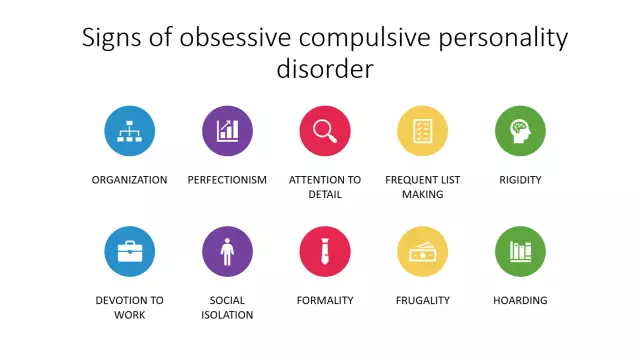- Author Rachel Wainwright [email protected].
- Public 2023-12-15 07:39.
- Last modified 2025-11-02 20:14.
Generalized anxiety disorder

If a person has an excessive daily feeling of anxiety and anxiety for six months, we can talk about generalized anxiety disorder (GAD).
Causes of Generalized Anxiety Disorder
The exact causes of the development of the disease are unknown. It can often be found in patients suffering from alcohol addiction, as well as from panic attacks and severe depression.
This disease is quite common. According to statistics, about 3% of the world's population fall ill every year. Moreover, women get sick twice as often as men. The disease is common in children and adolescents, but generalized anxiety disorder occurs in adults.
The disease is characterized by constant anxiety and fears arising from various circumstances or events that clearly do not require such anxiety. Students, for example, may have excessive fear of exams, even if they have good knowledge and high grades. People with GAD are often unaware of the excessiveness of their fears, but constant anxiety causes them discomfort.
To be able to diagnose GAD with confidence, symptoms must be present for at least six months, and anxiety must be uncontrolled.
Symptoms of Generalized Anxiety Disorder
In GAD, the immediate cause for anxiety is not as clearly identified as in various panic attacks. The patient can be anxious for a variety of reasons. The most common concerns are about professional commitments, constant lack of money, safety, health, car repairs, or other daily chores.
The characteristic symptoms of generalized anxiety disorder are: increased fatigue, anxiety, irritability, decreased concentration, sleep disturbance, and muscle tension. It should be noted that most patients with GAD already have one or more mental disorders, including panic disorder, depressive or social phobia, etc.
Clinically, GAD is manifested as follows: the patient feels constant anxiety and tension caused by a series of events or actions for six months or more. He cannot control this anxiety state, and it is accompanied by the above symptoms.
To diagnose GAD in children, at least one of the six symptoms is sufficient. To diagnose generalized anxiety disorder in adults, at least three symptoms are required.
In GAD, the focus of anxiety and anxiety is not limited to motives that are characteristic of other anxiety disorders. Thus, anxiety and anxiety are not exclusively associated with fear of panic attacks (panic disorder), fear of large crowds (social phobia), weight gain (anorexia nervosa), fear of separation in childhood (separation anxiety disorder), the possibility of contracting a dangerous disease (hypochondria)) and others. Anxiety causes discomfort in the patient and prevents him from leading a fulfilling life.

Typically, symptoms of generalized anxiety disorder are caused by a variety of physical disorders (for example, hypothyroidism), as well as medication or drug use.
Risk factors
The chances of getting GAD are increased when:
- female;
- low self-esteem;
- exposure to stress;
- smoking, using alcohol, drugs or drugs that cause dependence;
- long stay under the influence of one or more negative factors (poverty, violence, etc.);
- family members have anxiety disorders.
Diagnosis of Generalized Anxiety Disorder
At the consultation, the doctor performs a physical examination of the patient, asks him about the history and symptoms of the disease. Diagnosing a disease involves doing research to identify other diseases that may have triggered GAD (such as thyroid disease).
The doctor asks the patient what medications they are taking, as some of them can cause serious side effects similar to those of GAD. Also, the doctor will definitely ask if the patient is addicted to tobacco, alcohol or drugs.
An accurate diagnosis of GAD is made when the following factors are present:
- GAD symptoms last for six months or more;
- they cause significant discomfort for the patient and prevent him from leading a full life (for example, the patient is forced to skip school or work);
- GAD symptoms are persistent and uncontrollable.
Treatment for generalized anxiety disorder
Typically, treatment for generalized anxiety disorder consists of the following:
- Cognitive Behavioral Therapy. The patient is taught to change point of view and respond more calmly to disturbing situations.
- Behavioral therapy. The patient is taught relaxation techniques, muscle relaxation, deep breathing, visualization. This helps the patient to control the feeling of anxiety, teaches him to stay calm. Occasionally, during therapy, the doctor may put a little stress on the patient in order to cause anxiety and anxiety. This allows him to observe the patient in an unfavorable environment for him.
- Biofeedback, which is done by attaching sensors to the body. This method helps the doctor understand the body's signals that respond to stimuli and decide on further treatment.
- Support groups. This therapy allows the patient to share their experiences and find out how other people have dealt with a similar condition.
- Taking medications. Medication is prescribed for a patient if symptoms of GAD interfere with his normal life and work. It is important to note that many medications cannot be stopped on their own, so you should consult your doctor before stopping.
Medicines for generalized anxiety disorder include:
- Benzodiazepines, which help relax muscles and prevent muscle tension in response to disturbing thoughts. These medications are taken under the strict supervision of a physician as they can be addictive.
- Anxiety-reducing drugs such as Buspirone, Alprazolam;
- Antidepressants (mainly serotonin reuptake inhibitors).
- Beta blockers to relieve the physical symptoms of GAD.
For the most successful treatment of GAD, it is important to identify the disease as early as possible, as this can reduce the risk of severe psychological complications.
To reduce the symptoms of GAD, it is recommended to avoid the use of nicotine, caffeine and other drugs that contribute to nervous arousal.
YouTube video related to the article:
The information is generalized and provided for informational purposes only. At the first sign of illness, see your doctor. Self-medication is hazardous to health!


